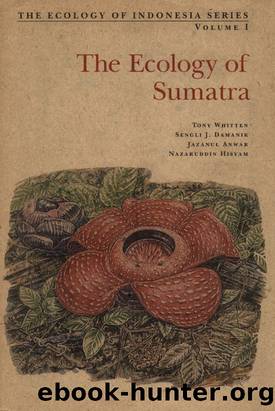Ecology of Sumatra by Tony Whitten & Sengli J. Damanik

Author:Tony Whitten & Sengli J. Damanik [Whitten, Tony & Damanik, Sengli J.]
Language: eng
Format: epub
Tags: nature, ecology, Travel, Asia, Southeast, Special Interest, Ecotourism, Ecosystems & Habitats, Forests & Rainforests, Regional
ISBN: 9781462905089
Google: 9QzRAgAAQBAJ
Publisher: Tuttle
Published: 2012-06-26T20:30:44+00:00
After Lloyd et al. 1968
Leaf samples from padang and heath forest were collected by the CRES team but the results of the chemical analyses are not yet available.
Fauna of Pitcher Plants. Pitcher plants provide an excellent example of an ecological microcosm. It is well known that insects are lured into the pitchers where they slip on the smooth, waxy lip and drown in the pool of water held in the bottom of the pitcher. Glands inside the pitcher secrete digestive enzymes and so the nutrients from the corpses are available to the plant.
It is less well known, however, that the water inside a pitcher supports a community of insect larvae and other organisms which are resistant to the digestive enzymes. Most of these animals feed directly on the drowned insects or feed indirectly on them by being predators on bacteria and other microorganisms which have themselves fed on the corpses. Since many of these species spend only the early part of their life cycle inside pitchers, they represent an export of nutrients which would otherwise have been used by the plant (Beaver 1979c, d).
Thienemann (1932, 1934) documented the fauna of pitcher plants in Sumatra, but the only study to consider the ecology of these unlikely communities is by Beaver, who worked on Penang Island. In the three species of pitcher plants examined (Nepenthes albomarginata, N. ampullaria and N. gracilis) he found 25 species of insect and three species of arachnid. The predominant family was Culicidae or true mosquitoes, but eight other families of flies (order Diptera) were found as well as representatives of the Hymenoptera (bees, wasps, ants), Lepidoptera (butterflies and moths), Araneae (spiders) and Acari (mites). Bacteria, protozoans, rotifers, nematode worms, oligochaete worms and crustaceans are also known from pitcher plants but these occur most frequently in old pitchers which have been deserted by insects and arachnids. These old pitchers no longer attract prey and so the input of nutrients is low and population levels of these microorganisms can never become high. Microorganisms are probably infrequent in younger, attractive pitchers because of the filter-feeding activities of some mosquito larvae. A negative correlation between protozoa and mosquito larvae in such habitats in North America was shown by Addicott (1974).
Download
This site does not store any files on its server. We only index and link to content provided by other sites. Please contact the content providers to delete copyright contents if any and email us, we'll remove relevant links or contents immediately.
| Fisheries & Aquaculture | Forests & Forestry |
The Lonely City by Olivia Laing(4746)
Animal Frequency by Melissa Alvarez(4394)
All Creatures Great and Small by James Herriot(4228)
Walking by Henry David Thoreau(3892)
Exit West by Mohsin Hamid(3776)
Origin Story: A Big History of Everything by David Christian(3648)
COSMOS by Carl Sagan(3553)
How to Read Water: Clues and Patterns from Puddles to the Sea (Natural Navigation) by Tristan Gooley(3406)
Hedgerow by John Wright(3272)
The Inner Life of Animals by Peter Wohlleben(3259)
How to Read Nature by Tristan Gooley(3248)
How to Do Nothing by Jenny Odell(3231)
Project Animal Farm: An Accidental Journey into the Secret World of Farming and the Truth About Our Food by Sonia Faruqi(3174)
Origin Story by David Christian(3145)
Water by Ian Miller(3126)
A Forest Journey by John Perlin(3026)
The Plant Messiah by Carlos Magdalena(2881)
A Wilder Time by William E. Glassley(2817)
Forests: A Very Short Introduction by Jaboury Ghazoul(2790)
